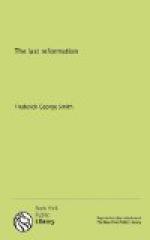The time period first specified in this special scene is the same twelve hundred and sixty years that marks the reign of the beast and therefore closes with the reformation of the sixteenth century. We shall have occasion to return to this series later and trace its predictions down to our own times.
CHAPTER XIII
ERA OF MODERN SECTS
[Sidenote: Another epoch predicted]
We have seen that the 1,260-year universal reign of the first beast of Revelation 13 ends with the period of the Reformation. The exact manner in which this should be accomplished is not definitely given in the prophecy, aside from the statement, “He that leadeth into captivity shall go into captivity: he that killeth with the sword must be killed with the sword” (verse 10). This description would seem to indicate a period of captivity in which the papacy would be deprived of its great power, after which it would be finally destroyed; and this agrees with Paul’s description of the papacy in 2 Thessalonians 2, where he speaks of that Wicked “whom the Lord shall consume with the spirit of his mouth, and shall destroy with the brightness of his coming” (verse 8). And Daniel, speaking of the end of the 1,260-year reign of the same papal beast, points out a reformation time when “they shall take away his dominion, to consume and to destroy it unto the end” (Dan. 7:26).
There is no doubt that these references point out the work of the Reformation which broke the power of Rome’s universal supremacy and her long reign of tyranny over the earth. Humanism, discovery of the art of printing, the revival of learning, and other causes contributed to this result. But the real revolt came in 1517, when Luther in Saxony nailed to the church door in Wittenberg his ninety five theses against the papal traffic in indulgences. The Reformers made their appeal from the decisions of Councils to the inspired Word of God, and this was the secret of their success. With wonderful power and boldness they proclaimed truth that had been neglected or discredited for ages. The holy fire spread over Western Europe. Men became agitated as if moved by a mighty unseen power, until the papacy was shaken from end to end.
[Sidenote: Protestantism in prophecy]
We regret that the true work of reformation did not long continue. A.D. 1530 marks a new epoch—the rise of organized Protestantism; marks the end of the 1,260-year period, and the introduction of another ecclesiastical power. The historian D’Aubigne recognizes the distinction between the Reformation as such and organized Protestantism. In his well-known work, History of the Reformation, he says: “The first two books of this volume contained the most important epochs of the Reformation—the Protest of Spires and the Confession of Augsburg.... I determined on bringing the reformation of Germany and German-Switzerland




